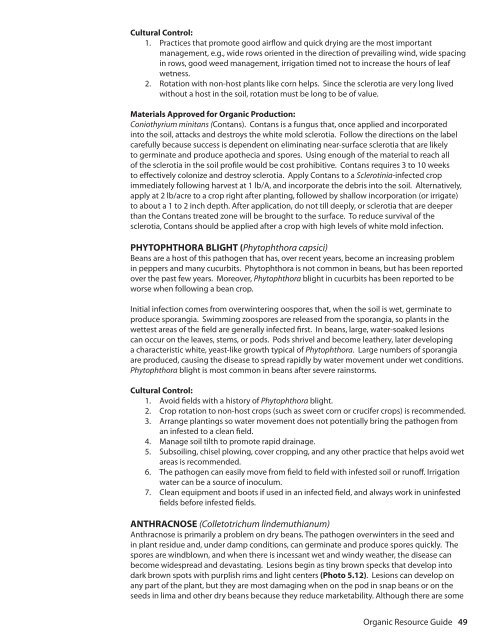Resource Guide for Organic Insect and Disease ... - Cornell University
Resource Guide for Organic Insect and Disease ... - Cornell University
Resource Guide for Organic Insect and Disease ... - Cornell University
You also want an ePaper? Increase the reach of your titles
YUMPU automatically turns print PDFs into web optimized ePapers that Google loves.
Cultural Control:<br />
1. Practices that promote good airflow <strong>and</strong> quick drying are the most important<br />
management, e.g., wide rows oriented in the direction of prevailing wind, wide spacing<br />
in rows, good weed management, irrigation timed not to increase the hours of leaf<br />
wetness.<br />
2. Rotation with non-host plants like corn helps. Since the sclerotia are very long lived<br />
without a host in the soil, rotation must be long to be of value.<br />
Materials Approved <strong>for</strong> <strong>Organic</strong> Production:<br />
Coniothyrium minitans (Contans). Contans is a fungus that, once applied <strong>and</strong> incorporated<br />
into the soil, attacks <strong>and</strong> destroys the white mold sclerotia. Follow the directions on the label<br />
carefully because success is dependent on eliminating near-surface sclerotia that are likely<br />
to germinate <strong>and</strong> produce apothecia <strong>and</strong> spores. Using enough of the material to reach all<br />
of the sclerotia in the soil profile would be cost prohibitive. Contans requires 3 to 10 weeks<br />
to effectively colonize <strong>and</strong> destroy sclerotia. Apply Contans to a Sclerotinia-infected crop<br />
immediately following harvest at 1 lb/A, <strong>and</strong> incorporate the debris into the soil. Alternatively,<br />
apply at 2 lb/acre to a crop right after planting, followed by shallow incorporation (or irrigate)<br />
to about a 1 to 2 inch depth. After application, do not till deeply, or sclerotia that are deeper<br />
than the Contans treated zone will be brought to the surface. To reduce survival of the<br />
sclerotia, Contans should be applied after a crop with high levels of white mold infection.<br />
PHYTOPHTHORA BLIGHT (Phytophthora capsici)<br />
Beans are a host of this pathogen that has, over recent years, become an increasing problem<br />
in peppers <strong>and</strong> many cucurbits. Phytophthora is not common in beans, but has been reported<br />
over the past few years. Moreover, Phytophthora blight in cucurbits has been reported to be<br />
worse when following a bean crop.<br />
Initial infection comes from overwintering oospores that, when the soil is wet, germinate to<br />
produce sporangia. Swimming zoospores are released from the sporangia, so plants in the<br />
wettest areas of the field are generally infected first. In beans, large, water-soaked lesions<br />
can occur on the leaves, stems, or pods. Pods shrivel <strong>and</strong> become leathery, later developing<br />
a characteristic white, yeast-like growth typical of Phytophthora. Large numbers of sporangia<br />
are produced, causing the disease to spread rapidly by water movement under wet conditions.<br />
Phytophthora blight is most common in beans after severe rainstorms.<br />
Cultural Control:<br />
1. Avoid fields with a history of Phytophthora blight.<br />
2. Crop rotation to non-host crops (such as sweet corn or crucifer crops) is recommended.<br />
3. Arrange plantings so water movement does not potentially bring the pathogen from<br />
an infested to a clean field.<br />
4. Manage soil tilth to promote rapid drainage.<br />
5. Subsoiling, chisel plowing, cover cropping, <strong>and</strong> any other practice that helps avoid wet<br />
areas is recommended.<br />
6. The pathogen can easily move from field to field with infested soil or runoff. Irrigation<br />
water can be a source of inoculum.<br />
7. Clean equipment <strong>and</strong> boots if used in an infected field, <strong>and</strong> always work in uninfested<br />
fields be<strong>for</strong>e infested fields.<br />
ANTHRACNOSE (Colletotrichum lindemuthianum)<br />
Anthracnose is primarily a problem on dry beans. The pathogen overwinters in the seed <strong>and</strong><br />
in plant residue <strong>and</strong>, under damp conditions, can germinate <strong>and</strong> produce spores quickly. The<br />
spores are windblown, <strong>and</strong> when there is incessant wet <strong>and</strong> windy weather, the disease can<br />
become widespread <strong>and</strong> devastating. Lesions begin as tiny brown specks that develop into<br />
dark brown spots with purplish rims <strong>and</strong> light centers (Photo 5.12). Lesions can develop on<br />
any part of the plant, but they are most damaging when on the pod in snap beans or on the<br />
seeds in lima <strong>and</strong> other dry beans because they reduce marketability. Although there are some<br />
<strong>Organic</strong> <strong>Resource</strong> <strong>Guide</strong> 49







